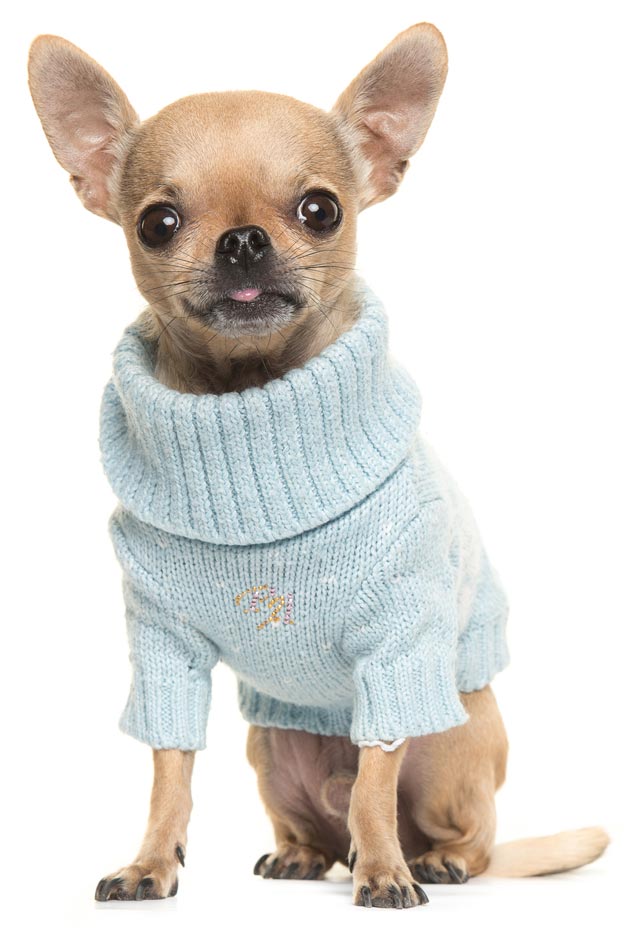How to Tell If Your Dog Needs a Sweater

Dog sweaters are pretty cute. You can buy them in all sizes, colors, weights, and patterns. Some dogs hate them, but many dogs are willing to wear them without any fuss. But how do you know if your dog actually needs to wear a sweater or coat? Here are some questions to answer; they'll help you determine whether your dog needs some winter sweater protection.
What Kind of Hair Coat Does Your Dog Have?
Dogs with double coats like huskies, Newfoundlands, and Alaskan malamutes don't need sweaters to deal with snow or a walk in cold weather. These dogs evolved in cold climates, and as long as they are healthy, they'll be fine in most cold weather conditions. In fact, many of these northern breed dogs love the cold and are actually more energetic and playful during the winter than they are during the summer. They might even dangerously overheat if you put clothes on them in cold weather. Of course, no dog should be left outside for long periods of time in frigid weather, low wind chills, or a winter storm.
How Big Is Your Dog?
Small dogs are more likely to need extra protection in cold weather than large dogs are. With less body surface, they aren't as able to generate and maintain body heat as larger dogs are. Many small dog breeds also have short hair and no double coat, so they don't have the defense against cold that long-haired, double-coated dogs do.
How Old Is Your Dog?
Young dogs and old dogs are more likely to need to wear sweaters during cold weather than healthy adults are. Puppies and old dogs are less able to keep their body temperatures stable. You should consider a sweater or coat for dogs in those life stages, especially short-haired ones.
What Medical Conditions Does Your Dog Have?
A dog with a medical condition like cancer, diabetes, or a heart problem will be less likely to be able to tolerate cold conditions as well as completely healthy dogs can. When a dog has a medical condition, their body is busy maintaining things, and any stressor, including cold, can tumble everything out of balance. Keeping your sick dog warm will help ease the load for all of the bodily systems that are already working harder than normal to keep things stable.
How Much Body Fat Does Your Dog Have?
Certain dog breeds are naturally thin, like greyhounds and whippets, and they probably need a sweater when it's cold. Less fat equals less ability to conserve body heat, so it's safer for them to be wearing something to help them do so.
Does Your Dog Have Arthritis?
A dog with joint problems often suffers more in the winter than during warm weather. Protective clothes can help those dogs by keeping their joints warm, so they don't stiffen up. Your arthritic dog might also benefit from glucosamine supplements or NSAIDs during the winter, but you need to check with your veterinarian before giving any medications. Learn more here: "Arthritis in Dogs."
How Tall Is Your Dog?
Short dogs with bellies that are close to the ground probably need a jacket or sweater. The cold ground or the snow on top of it being close to your dog's stomach, which is the core of the body, will make it more difficult for your dog to keep warm. Taller dogs with more of a buffer between their stomach and the cold ground or snow layer are less likely to need a sweater.
What About Booties?
Booties are useful for most dogs during the winter. Not only can they keep the paws which, as extremities, are more prone to getting too cold, warmer, they can also decrease slipping in icy conditions.
Not only that, but booties can help keep rock salt and antifreeze, two winter toxins, off of your dog's feet, where they can do corrosive damage or be swallowed when the dog licks them off. Another bonus is that the booties can be removed upon entering your home, decreasing the snow, dirt, and ice that gets in.
Take a look at this article to learn more about paw pads and how booties can help: "Paw Pad Protection for Dogs."
Remove Dogs' Clothes While Inside
Sweaters, coats, and booties are outdoor wear for dogs. Take them off while your dog is inside to prevent overheating and skin problems from the clothes rubbing in certain spots.
Rather than keeping the sweater on your dog while inside, provide nice warm dog beds lined with cozy blankets.
Choose Your Dog's Clothes Wisely
If your small dog only needs a sweater for a few minutes to go outside and come back in, any sweater will probably do. However, if you and your big, short-haired dog are going for a hike in the woods, a waterproof coat and boots will keep him warm, while something that isn't waterproof won't. In fact, non-waterproof clothes might actually make your dog colder once they get wet and hold that frigid moisture right next to your dog's body.
Check Everything out Once It's on Your Dog
Once you get your dog's sweater and booties on, look everything over to make sure that there isn't any zipper, Velcro, or loose material that is rubbing on any area of your dog's body. Anything that is hanging, moving, or too tight could quickly and easily damage your dog's skin. Check everything over every time you put it on your dog.
You May Also Like These Articles:
Dog Shaving: Helpful or Harmful?
What Causes Premature Graying in Dogs?
Is My Dog Normal? 15 Dog Behaviors Explained - Slideshow
Disclaimer: This website is not intended to replace professional consultation, diagnosis, or treatment by a licensed veterinarian. If you require any veterinary related advice, contact your veterinarian promptly. Information at DogHealth.com is exclusively of a general reference nature. Do not disregard veterinary advice or delay treatment as a result of accessing information at this site. Just Answer is an external service not affiliated with DogHealth.com.
Notice: Ask-a-Vet is an affiliated service for those who wish to speak with a veterinary professional about their pet's specific condition. Initially, a bot will ask questions to determine the general nature of your concern. Then, you will be transferred to a human. There is a charge for the service if you choose to connect to a veterinarian. Ask-a-Vet is not manned by the staff or owners of DogHealth.com, and the advice given should not delay or replace a visit to your veterinarian.



